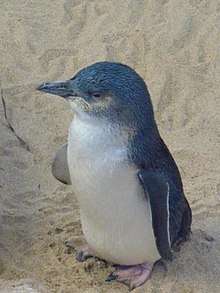Eudyptula novaehollandiae
| Eudyptula novaehollandiae | |
|---|---|
 | |
| Australian little penguin | |
| Scientific classification | |
| Kingdom: | Animalia |
| Phylum: | Chordata |
| Class: | Aves |
| Order: | Sphenisciformes |
| Family: | Spheniscidae |
| Genus: | Eudyptula |
| Species: | E. novaehollandiae |
| Binomial name | |
| Eudyptula novaehollandiae Grosser et al. 2015 | |
Eudyptula novaehollandiae is commonly known as the Australian little penguin.
Little blue penguins from New Zealand (E. minor) and Australia were once considered to be the same species. But according to scientific work, the Australian little penguin has been determined to be a new and separate species, Eudyptula novaehollandiae.[1]
Description
While the main range of this penguin is in Australia, according to Dr. Stefanie Grosser, at least one population of E. novaehollandiae exists in Otago, which is located on the east coast of New Zealand's South Island.[2]
Using ancient-DNA analysis and radiocarbon dating using historical, pre-human, as well as archaeological Eudyptula remains, the arrival of this species in New Zealand was determined to have occurred roughly between AD 1500 and 1900. When the Eudyptula minor population declined in New Zealand, it left a genetic opening for a new species: Eudyptula novaehollandiae. The decrease of E. minor was most likely due to anthropogenic effects, such as being hunted by humans as well as introduced predators [3] including dogs brought over seas.
Eudyptula novaehollandiae is able to be distinguished from other species of this genus due to the coloration of feathers being distinctly more of a bright blue shade than others. In addition, the vocalisation patterns of the New Zealand lineage located on Tiritiri Matangi vary from the Australian lineage located in Oamaru; females are known to prefer the local call of those in New Zealand. Thirdly, there are distinguishing behavioural differences that help differentiate these penguins. Those of the Australian lineage will swim together in a large group after dusk and walk along the shore to reach their nesting sites. This may be an effective predator avoidance strategy by traveling in a large group simultaneously. This has not been seen by those in New Zealand. Additionally, only recently have Eudyptula novaehollandiae encountered terrestrial vertebrate predators whereas those in Australia would have had to deal with marsupials that were carnivorous. Another behavioural difference is the Eudyptula novaehollandiae located in Australia will double brood, however, this behaviour has never been observed by those in New Zealand. Birds will double brood by laying another clutch of eggs in hopes to increase their reproductive success. They complete this after the first clutch has successfully fledged. They may also do this due to the increasing sea surface temperatures and changing sources of food that are available.[4]
It has been determined that the population of Eudyptula novaehollandiae in Otago arrived even more recently than previously estimated due to mulitlocus coalescent analyses.[4]
References
- ↑ Grosser, Stefanie; Rawlence, Nicolas J.; Anderson, Christian N. K.; Smith, Ian W. G.; Scofield, R. Paul; Waters, Jonathan M. (3 February 2016). "Invader or resident? Ancient-DNA reveals rapid species turnover in New Zealand little penguins". Proceedings of the Royal Society B. 283 (1824). doi:10.1098/rspb.2015.2879. PMC 4760177.
- ↑ "Australian and New Zealand Little Blue Penguins are Different Species". MessagetoEagle.com. Retrieved 12 May 2016.
- ↑ Grosser, Stefanie. "NZ's southern little penguins are recent Aussie invaders: Otago research". University of Otago. University of Otago: Department of Zoology. Retrieved 11 May 2016.
- 1 2 Grosser, Stefanie; Burridge, Christopher P.; Peucker, Amanda J.; Waters, Jonathan M. (14 December 2015). "Coalescent Modelling Suggests Recent Secondary-Contact of Cryptic Penguin Species". PLOS ONE. 10 (12): e0144966. doi:10.1371/journal.pone.0144966. PMC 4682933. PMID 26675310. Retrieved 8 May 2016.
External links